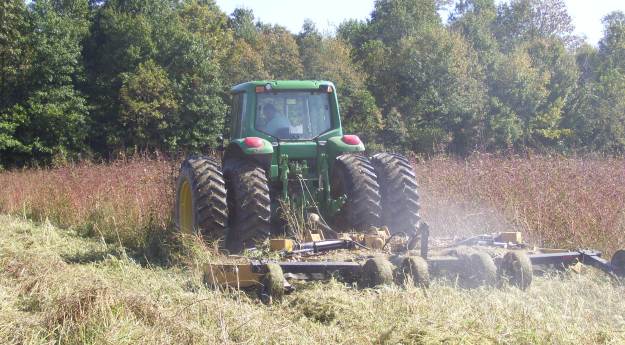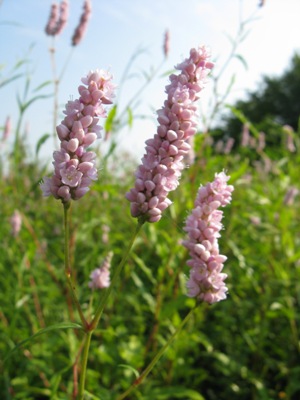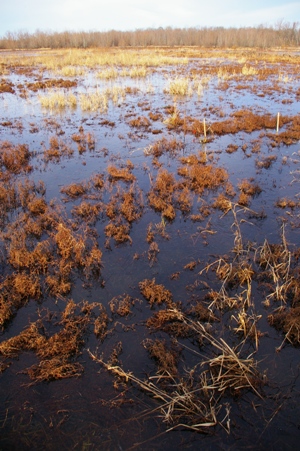
By Heath Hagy and Richard Kaminski
If you’re a waterfowl hunter, a bird watcher, or even a casual fan of some waterfowl habitat management shows on television, you may have heard of “moist-soil management.” It is simply the strategy of encouraging natural wetland plants to grow so waterfowl, especially ducks, can benefit from eating a diversity of seeds, tubers, and aquatic invertebrates.
Moist-soil plants often are considered by farmers, gardeners, landscapers, and the general public to be “weeds.” These “weeds” grow in ditches, lowlands, lawns, roadsides, and other places with moist soils. Since the 1920s, duck hunters and waterfowl managers have recognized the importance of moist-soil seeds and tubers in the diets of waterfowl. These natural foods are as important today as they were historically, before waterfowl foraged extensively on agricultural crops. However, research on active management strategies only dates back to the 1980s, when scientists in Missouri began trying different management practices to attract ducks and other waterfowl to moist-soil wetlands.
 After many years of research, habitat managers have become skilled at growing moist-soil plants to produce abundant seeds, tubers, and invertebrates for ducks. In fact, sometimes managers do such a nice job that these plants thrive and become tall and grow densely, especially in southern environments. The density of plants may become so great that ducks have a tough time alighting in these food-rich habitats.
After many years of research, habitat managers have become skilled at growing moist-soil plants to produce abundant seeds, tubers, and invertebrates for ducks. In fact, sometimes managers do such a nice job that these plants thrive and become tall and grow densely, especially in southern environments. The density of plants may become so great that ducks have a tough time alighting in these food-rich habitats.
In the 1990s, Dr. Rick Kaminski and Dr. Matt Gray of Mississippi State University recognized this problem and began researching ways to improve tall and dense stands of moist-soil vegetation for ducks. They mowed, tilled, or disked tall and dense moist-soil vegetation in the fall and evaluated which treatments resulted in increased food availability and an improved plant community for ducks. They demonstrated that disking improved the plant community in the subsequent year, and mowing moist-soil vegetation in autumn resulted in large increases in aquatic invertebrates for wintering ducks after these wetlands flooded.
Beginning in 2006, Dr. Kaminski and Dr. Heath Hagy, also of Mississippi State University, performed a complementary study to test if ducks were attracted to mowed, disked, or non-manipulated moist-soil vegetation. For three years, Dr. Hagy traveled all over the Mississippi Alluvial Valley and observed ducks using moist-soil wetlands that had been mowed, disked, or left untreated. He found that wintering ducks avoided tall and dense vegetation, and used mowed and disked areas more often. Common waterfowl observed included mallard, gadwall, green and blue-winged teal, American wigeon, northern pintail, American black duck, lesser scaup, ring-necked duck, and a whole host of other waterbirds.
 Additionally, Dr. Hagy found that duck foods were almost as abundant in mowed areas as in areas with standing vegetation. However, foods tended to be 30 percent less in disked areas, likely because seeds were buried by disking. Moreover, the researchers found that most ducks fed in two to six inches of water and abandoned wetlands when water levels rose above 30 inches. Hence, providing shallow water may be as important as manipulating vegetation when attract dabbling ducks to moist-soil wetlands. When used in combination, partial autumn mowing and shallow water can attract a wide variety of ducks and other waterbirds to moist-soil wetlands.
Additionally, Dr. Hagy found that duck foods were almost as abundant in mowed areas as in areas with standing vegetation. However, foods tended to be 30 percent less in disked areas, likely because seeds were buried by disking. Moreover, the researchers found that most ducks fed in two to six inches of water and abandoned wetlands when water levels rose above 30 inches. Hence, providing shallow water may be as important as manipulating vegetation when attract dabbling ducks to moist-soil wetlands. When used in combination, partial autumn mowing and shallow water can attract a wide variety of ducks and other waterbirds to moist-soil wetlands.
If you have densely overgrown natural vegetation in your duck hole, we recommend partially mowing sections of the wetland in autumn, after most seeds have matured. In southeastern United States, mowing after October 1st is generally best. However, if you desire to create some teal or shore bird habitat in September, mowing or bush-hogging small openings in late August can also be a great attractant. Remember, it is illegal to manipulate any planted vegetation in the year of planting, such as Japanese millet, corn, or soybeans. Because moist-soil vegetation is not planted, but natural vegetation, it can be mowed, disked, or otherwise managed any time of the year.
Ducks are most attracted to wetlands with approximately equal coverage of vegetation and open water. Scientists refer to this arrangement as “hemi-marshes,” meaning half vegetation and half open water in a random or interspersed pattern. There is no right or wrong way to create the openings for ducks, so feel free to have a little fun with it. In November, when the ducks start arriving, make sure you have some shallow water just covering the mowed areas and the ducks should certainly find your wetland and thank you for your efforts.
For more information, contact Dr. Heath Hagy (Illinois Natural History Survey), Dr. Richard Kaminski, or Dr. Brian Davis (Mississippi State University), or check out many helpful resources online for tips managing your wildlife habitat. If you are interested in reading more about moist-soil management and learning to identify these plants, explore the book A Guide to Moist-Soil Wetland Plants of the Mississippi Alluvial Valley (Schummer et al. 2012). The book is fully illustrated and is available through online retailers, local bookstores, and the University Press of Mississippi.




























